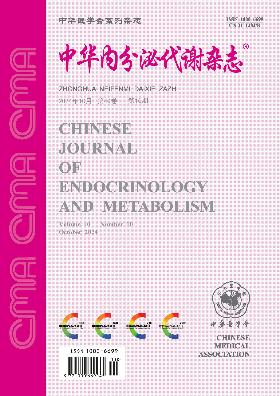Graves病复发危险因素及预测模型的抗甲状腺药物研究进展
Q4 Medicine
引用次数: 0
摘要
Graves病,也称为弥漫性毒性甲状腺肿,是一种甲状腺激素分泌增加的自身免疫性疾病。Graves病有三种有效的治疗方法,包括抗甲状腺药物(ATD)、放射性碘和甲状腺切除术。总的来说,ATD是国内医生治疗Graves病的首选,但复发率高一直是ATD治疗的不足。复发主要与性别、年龄、吸烟、病程、甲状腺肿等因素有关。其中,单一危险因素评估Graves病ATD治疗后复发率的可靠性和适用性较差。多因素综合评分预测模型有助于早期患者选择最佳治疗方案,达到精准治疗的目的,提高Graves病药物治疗的缓解率。本文评估了ATD治疗后Graves病复发危险因素的可靠性,并对Graves病治疗后复发事件(GREAT)评分、GREAT+评分和临床严重程度评分(CSS)等预测模型的开发和应用进行了综述。关键词:抗甲状腺药物;Graves病复发;风险因素;预测模型本文章由计算机程序翻译,如有差异,请以英文原文为准。
Advances in research on anti-thyroid drugs for recurrence risk factors and predictive models of Graves′ disease
Graves′ disease, also known as diffuse toxic goiter, is an autoimmune disease with increased secretion of thyroid hormone. There are three effective treatments for Graves′ disease, which including anti-thyroid drugs (ATD), radioactive iodine and thyroidectomy. In general, ATD is the first choice of Graves′ disease treatment for domestic physicians, but the high recurrence rate has always been the deficiency of ATD treatment. Recurrence is mainly related to gender, age, smoking, course of disease, goiter and other factors. Among them, the reliability and applicability of single risk factor in evaluating the recurrence rate of Graves′ disease after ATD treatment are poor. The prediction model of multi-factor comprehensive score is helpful for the naive patients to choose the best treatment plan, to achieve the goal of precise treatment and to improve the remission rate of Graves′ disease drug treatment. In this paper, the reliability of risk factors for Graves′ disease recurrence after ATD treatment is evaluated, and the development and application of prediction models such as Graves′ recurrent events after therapy (GREAT) score, GREAT + score, and clinical severity score (CSS) are reviewed.
Key words:
Anti-thyroid drugs; Recurrence of Graves′ disease; Risk factor; Predictive model
求助全文
通过发布文献求助,成功后即可免费获取论文全文。
去求助
来源期刊

中华内分泌代谢杂志
Medicine-Endocrinology, Diabetes and Metabolism
CiteScore
0.60
自引率
0.00%
发文量
7243
期刊介绍:
The Chinese Journal of Endocrinology and Metabolism was founded in July 1985. It is a senior academic journal in the field of endocrinology and metabolism sponsored by the Chinese Medical Association. The journal aims to be the "Chinese broadcaster of new knowledge on endocrinology and metabolism worldwide". It reports leading scientific research results and clinical diagnosis and treatment experience in endocrinology and metabolism and related fields, as well as basic theoretical research that has a guiding role in endocrinology and metabolism clinics and is closely integrated with clinics. The journal is a core journal of Chinese science and technology (a statistical source journal of Chinese science and technology papers), and is included in Chinese and foreign statistical source journal databases such as the Chinese Science and Technology Papers and Citation Database, Chemical Abstracts, and Scopus.
 求助内容:
求助内容: 应助结果提醒方式:
应助结果提醒方式:


